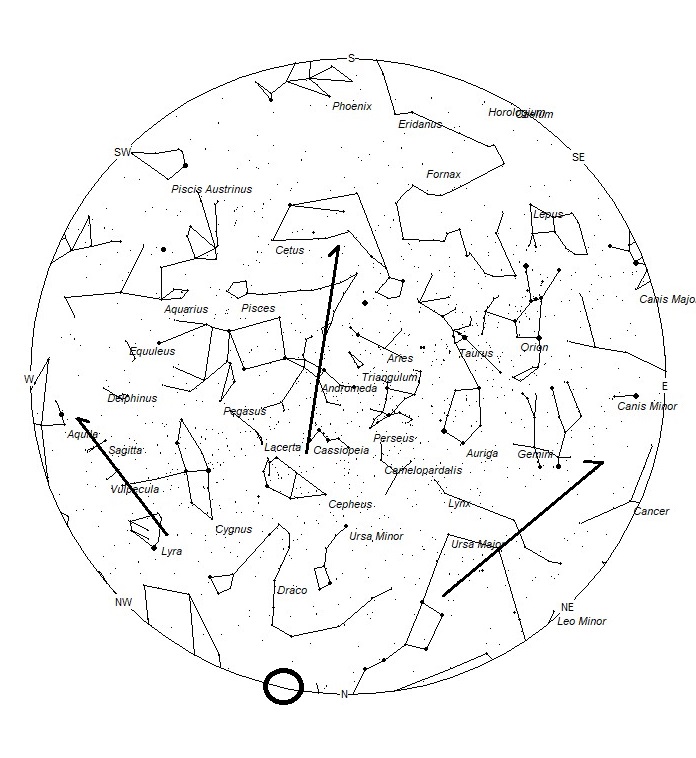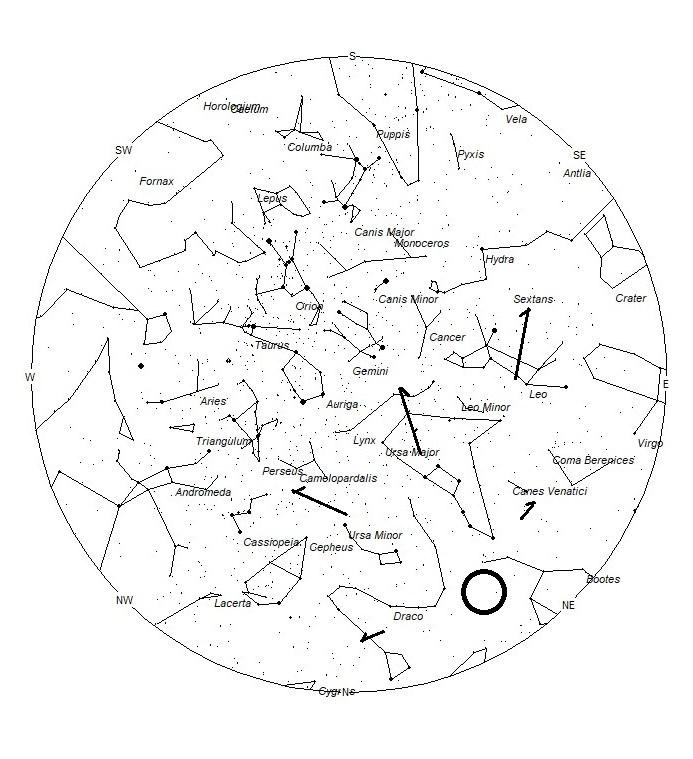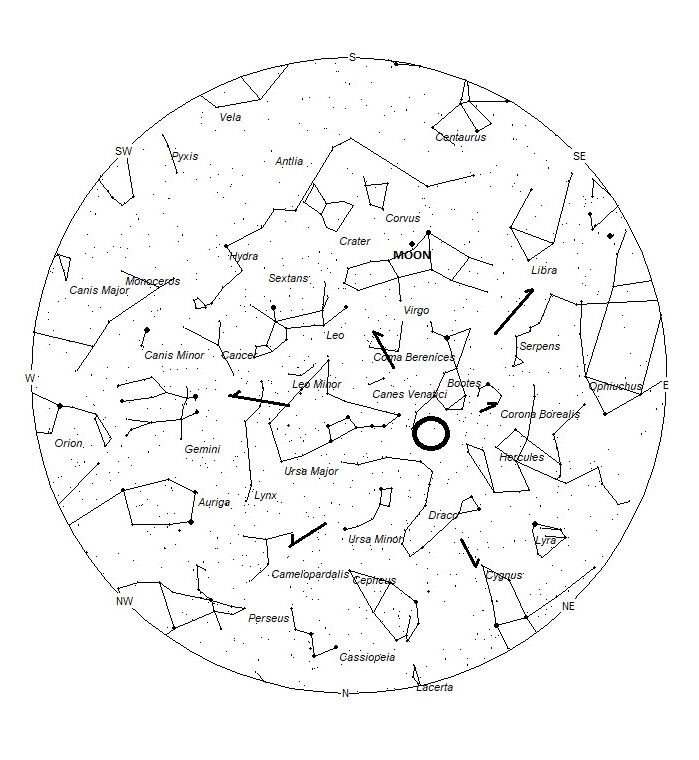The illustration above displays the orbits of actual Quadrantid meteors captured on multiple video cameras. The angle of the view in this illustration can be altered by using your mouse pointer. Scroll to zoom. Courtesy Dr. Peter Jenniskens, the SETI Institute, California USA
The Quadrantids can be one of the strongest displays of the year, yet they are difficult to observe. The main factor is that the display of strong activity only has a duration of about 6 hours. The reason the peak is so short is due to the shower’s thin stream of particles and the fact that the Earth crosses the stream at a perpendicular angle. Therefore the Earth passes through the densest portion of the stream quite quickly. Meteors from this source can be seen for two weeks centered on January 4th, but hourly rates away from the date of maximum activity are very low. Unlike most meteor showers which originate from comets, the Quadrantids have been found to originate from an asteroid. Asteroid 2003 EH1 takes 5.52 years to orbit the sun. It is possible that 2003 EH1 is a “dead comet” or a new kind of object being discussed by astronomers sometimes called a “rock comet.”
These meteors were first noted in 1825 and appeared to radiate from the obsolete constellation of Quadrans Muralis (Mural Quadrant). Today, this area of the sky lies within the boundaries of the constellation of Boötes the herdsman. During early January nights as seen from the northern hemisphere, this area of the sky lies very low in the northwest in the evening sky. Very little activity is normally seen at this time. As the night progresses this area of the sky swings some 40 degrees beneath the northern celestial pole. From areas south of 40 degrees north latitude, it actually passes below the horizon. It then begins a slow rise into the northeastern sky where it obtains a useful altitude around 02:00 local standard time (depending on your latitude). It is between this time and dawn that you will have your best chance to view these meteors. If the peak occurs during this time you will be in for a treat as rates could exceed 100 per hour as seen from rural locations under a moonless sky. Unfortunately a half-illuminated moon will rise shortly after midnight this year and moonlight will tend to obscure the faintest meteors. While moonlight will be a nuisance, it is not nearly as bad when a full moon is present. Successful observations can be undertaken by facing northward away from the moon. Using a tree or building to block the moonlight will also help you view more activity.
The charts above depict the entire sky facing north during the evening, midnight, and morning hours as seen from 40 north latitude. The circle represents the position of the Quadrantid radiant on the night of January 3/4, 2024. The streaks represent Quadrantid meteors as seen throughout the night. Notice how the radiant lies on the horizon during the evening hours and slowly rises as the night progresses. It’s easy to see why more meteors are visible during the morning hours when the radiant lies higher in the sky and the horizon blocks less of the activity! Also notice in the chart for 5:00 that the moon now is present in the sky in the constellation of Virgo near the bright star known as Spica.
Predictions for the peak of the 2024 Quadrantids range from 9:00 to 15:00 Universal Time on January 4th. The earlier time favors North American observers while the later peak favors the eastern Pacific area including the Hawaiian Islands and Alaska. Those viewing from the southern hemisphere will not see much activity at all as the radiant does not rise very high in their sky before dawn intervenes.
The best strategy to see the most activity is to face the northern half of the sky with the moon at your back from 2:00 onward. By facing this direction you be able to see meteors shoot out of the radiant in all directions. This will make it easy to differentiate between the Quadrantids and meteors from other sources. To provide a scientific useful observing session one needs to carefully note the starting and ending time of your session. If you are able to provide the time of each meteor, that would help tremendously in analyzing the strength of the shower. The type of meteor needs to be recorded as well as its magnitude. Other parameters that can be recorded are colors, velocity (degrees per second or verbal description) and whether the meteor left a persistent train. Fireballs should be noted and a separate online form filled out after the session.
Serious observers should watch for at least an hour as numerous peaks and valleys of activity will occur. If you only few for a short time it may coincide with a lull of activity. Watching for at least an hour guarantees you will get to see the best this display has to offer. Observers are also encouraged to fill out a visual observing form on the website of the International Meteor Organization . You must register with the IMO to use the form, but there is an option of registering for free if you do not wish to become a full-fledged member. Data is often scarce for this display, especially when the moon interferes. Therefore if your skies are clear please make an effort to view this display. If will be your last opportunity to view enhanced meteor activity until the eta Aquariids peak in May.
The Quadrantids also offer those interested in observing meteor showers by radio a good opportunity to view strong activity. Meteors do not emit radio waves, but they act as mirrors and reflect radio waves from distant transmitters which aren’t heard otherwise. This is called forward scatter, opposed to backscatter where the transmitter and receiver are at the same place (radar). For practical reasons the frequency range 50 – 150 MHz (wavelength 6 m – 2 m) is used. This includes amongst others the FM band and TV transmitters which haven’t switched yet to digital. Most reflections are short (less than a second), but brighter meteors can cause reflections lasting minutes. The shortest radio reflections are caused by faint meteors, fainter than visual ones. Contrary to visual rates, the radio rates are not maximal when the radiant of a stream is in the zenith, but rather when it is 45 degrees high. For higher elevations, the rates decrease again. Radio reflections can be observed regardless of daylight, clouds, or moonlight, allowing more complete views of streams. The best timing to pick up Quadrantids would be near 04:00 and again near 13:00 (1pm) local standard time on January 4th. The Quadrantids activity is one of the best of the year, but lasts only one day.
We look forward to seeing your results!
Robert Lunsford & Christian Steyaert
 American Meteor Society
American Meteor Society



Just got in from one hour of observing from Raintree Lake Lee’s Summit, MO.
Saw 22 Quads and 4 sporadic meteors from 1018-1118 UT, 418-518 local Central time zone, USA. Blocked moon out of view observing NNE, 60 degrees up primarily.
They were very clumpy, getting 6 in the first ten min and 8 the last ten min of the session.
L Mag. was 5.0. Brightest was a -1, saw 2 0’s, and two +1’s, no trains. Saw a point +3 Quad as well.
This session was 47 years after my first session in 1976 w this shower.
26 degrees, light SW winds 5-7mph.
iGoaMgzXwCDqIQZL
This above report was for the morning of Jan. 4th, 2024. And I forgot, it was a 2024 report so 48 years since I first observed them.
UgwpGtnJVdD
jWunUherlksJgqY